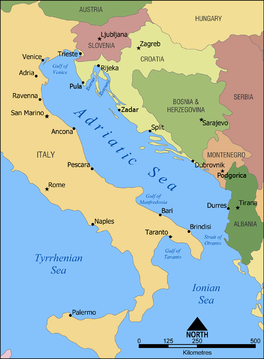Adriatic Sea
- 28 Sep 2021
- Recently, Croatian scientists have issued a public appeal for the protection of the Adriatic Sea, stressing that this is a precondition for the sustainable development of the society.
- The scientists claim that the changes are irreversible, from the increase in the temperature of the Adriatic Sea, the increase in levels and salinity to the appearance of storm waves.
- The scientists claim that various non-domicile, thermophilic species of fish, algae, bacteria and gelatinous organisms are increasingly appearing in the Adriatic.
- These invasive and poisonous organisms might significantly changes the biodiversity of the Adriatic Sea, according to the scientists.
- One of the phenomena includes the mass appearance of jellyfish, which ultimately harms tourism.
- Tourist activities with climate change put the greatest pressure on the Adriatic, and the consequence is that a larger amount of various harmful substances come into the sea.
- The danger for the Adriatic is also due to uncontrolled construction along the coast.
About Adriatic Sea

Source: Wikipedia
- The Adriatic Sea is a body of water separating the Italian Peninsula from the Balkans.
- The Adriatic is the northernmost arm of the Mediterranean Sea, extending from the Strait of Otranto (where it connects to the Ionian Sea) to the northwest and the Po Valley.
- The countries with coasts on the Adriatic are Albania, Bosnia and Herzegovina, Croatia, Italy, Montenegro and Slovenia.
- The Adriatic contains more than 1,300 islands, mostly located along the Croatian part of its eastern coast. It is divided into three basins, the northern being the shallowest and the southern being the deepest.




